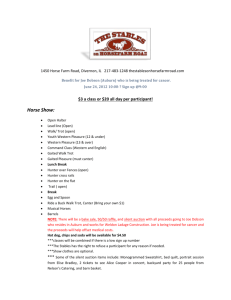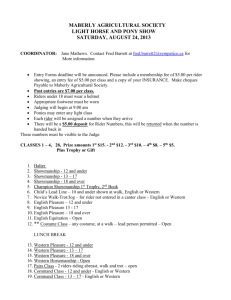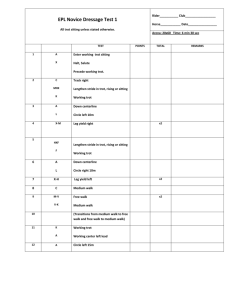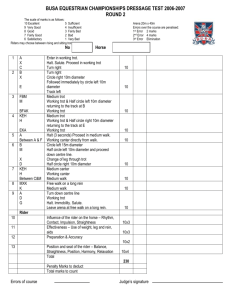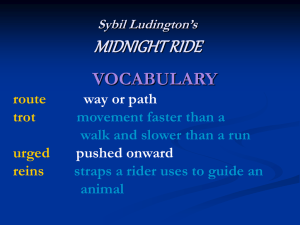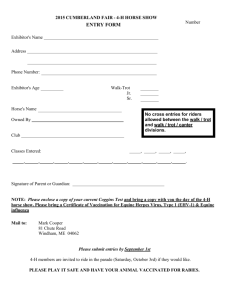korelacija svojstava koraka i tjelesnih mjera lipicanskih konja
advertisement
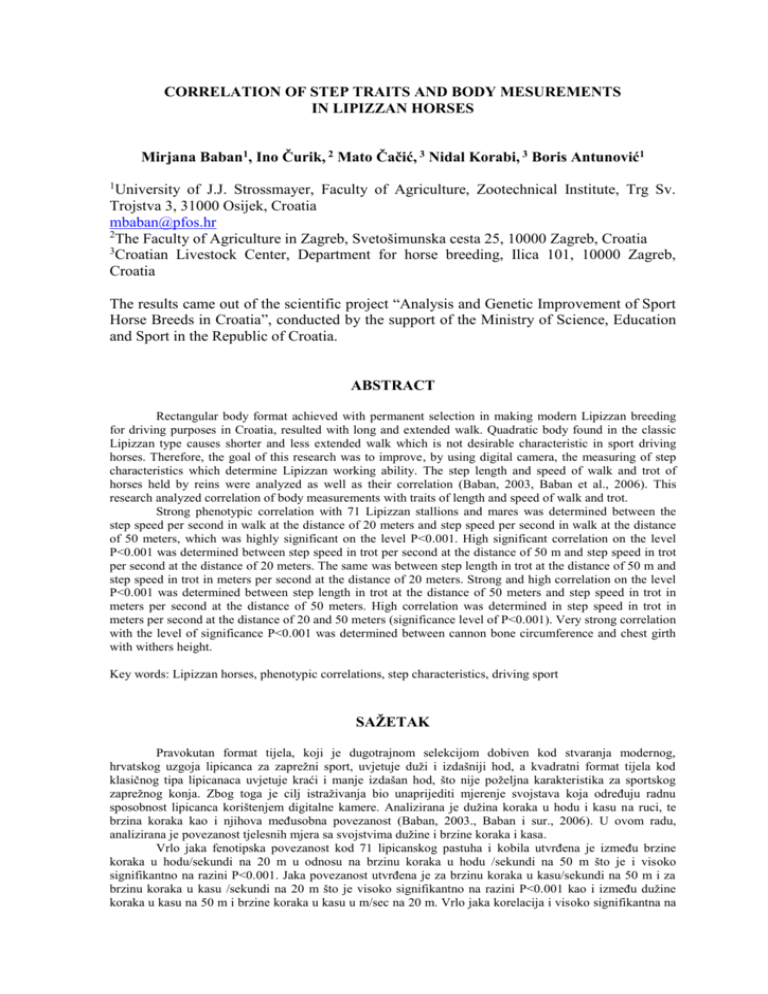
CORRELATION OF STEP TRAITS AND BODY MESUREMENTS IN LIPIZZAN HORSES Mirjana Baban1, Ino Čurik, 2 Mato Čačić, 3 Nidal Korabi, 3 Boris Antunović1 1 University of J.J. Strossmayer, Faculty of Agriculture, Zootechnical Institute, Trg Sv. Trojstva 3, 31000 Osijek, Croatia mbaban@pfos.hr 2 The Faculty of Agriculture in Zagreb, Svetošimunska cesta 25, 10000 Zagreb, Croatia 3 Croatian Livestock Center, Department for horse breeding, Ilica 101, 10000 Zagreb, Croatia The results came out of the scientific project “Analysis and Genetic Improvement of Sport Horse Breeds in Croatia”, conducted by the support of the Ministry of Science, Education and Sport in the Republic of Croatia. ABSTRACT Rectangular body format achieved with permanent selection in making modern Lipizzan breeding for driving purposes in Croatia, resulted with long and extended walk. Quadratic body found in the classic Lipizzan type causes shorter and less extended walk which is not desirable characteristic in sport driving horses. Therefore, the goal of this research was to improve, by using digital camera, the measuring of step characteristics which determine Lipizzan working ability. The step length and speed of walk and trot of horses held by reins were analyzed as well as their correlation (Baban, 2003, Baban et al., 2006). This research analyzed correlation of body measurements with traits of length and speed of walk and trot. Strong phenotypic correlation with 71 Lipizzan stallions and mares was determined between the step speed per second in walk at the distance of 20 meters and step speed per second in walk at the distance of 50 meters, which was highly significant on the level P<0.001. High significant correlation on the level P<0.001 was determined between step speed in trot per second at the distance of 50 m and step speed in trot per second at the distance of 20 meters. The same was between step length in trot at the distance of 50 m and step speed in trot in meters per second at the distance of 20 meters. Strong and high correlation on the level P<0.001 was determined between step length in trot at the distance of 50 meters and step speed in trot in meters per second at the distance of 50 meters. High correlation was determined in step speed in trot in meters per second at the distance of 20 and 50 meters (significance level of P<0.001). Very strong correlation with the level of significance P<0.001 was determined between cannon bone circumference and chest girth with withers height. Key words: Lipizzan horses, phenotypic correlations, step characteristics, driving sport SAŽETAK Pravokutan format tijela, koji je dugotrajnom selekcijom dobiven kod stvaranja modernog, hrvatskog uzgoja lipicanca za zaprežni sport, uvjetuje duži i izdašniji hod, a kvadratni format tijela kod klasičnog tipa lipicanaca uvjetuje kraći i manje izdašan hod, što nije poželjna karakteristika za sportskog zaprežnog konja. Zbog toga je cilj istraživanja bio unaprijediti mjerenje svojstava koja određuju radnu sposobnost lipicanca korištenjem digitalne kamere. Analizirana je dužina koraka u hodu i kasu na ruci, te brzina koraka kao i njihova međusobna povezanost (Baban, 2003., Baban i sur., 2006). U ovom radu, analizirana je povezanost tjelesnih mjera sa svojstvima dužine i brzine koraka i kasa. Vrlo jaka fenotipska povezanost kod 71 lipicanskog pastuha i kobila utvrđena je između brzine koraka u hodu/sekundi na 20 m u odnosu na brzinu koraka u hodu /sekundi na 50 m što je i visoko signifikantno na razini P<0.001. Jaka povezanost utvrđena je za brzinu koraka u kasu/sekundi na 50 m i za brzinu koraka u kasu /sekundi na 20 m što je visoko signifikantno na razini P<0.001 kao i između dužine koraka u kasu na 50 m i brzine koraka u kasu u m/sec na 20 m. Vrlo jaka korelacija i visoko signifikantna na razini P<0.001 utvrđena je između dužine koraka u kasu na 50 m i brzine koraka u kasu u m/sec na 50 m. Vrlo jaka povezanost utvrđena je s brzinom koraka u kasu u m/sec na 20 i 50 m (visoka signifikantnost na razini P<0.001). Vrlo jaka korelacija s visokom signifikantnošću na razini P<0.001 utvrđena je između opsega cjevanice i opsega prsa s visinom grebena. Ključne riječi: lipicanac, fenotipske korelacije, karakteristike koraka, zaprežni sport INTRODUCTION In Croatia, except for the only state Lipizzan Stud Farm in Đakovo, there is also the national federation, called Croatian Federation of Lipizzan Horse Breeder Associations (including ten associations and one private stud farm), authorised by the Ministry of Agriculture, Forestry and Water Management for independent implementation of the breeding programme. In the year 2006, the Stud Farm Đakovo celebrated 500 years of its foundation, 200 years of organized Lipizzan breeding and 60 years of the stallion station in Đakovo. Croatian Lipizzan breeding, especially as a driving horse, is much respected not only in Europe but also world-wide. Lipizzan horses in Croatia are well known in international driving circles. Last year, at the world championship in Warka (Poland) all two-in-drive competitions have been successfully driven. Championships in Croatia (dressage, marathon, driving between tenpins) are organized according to FEI (Federation Equestre Internationale) rules (Baban et al. 2007). According to Barrey (2001), locomotive apparatus is a complex consisting of systems that include muscles, bones and joints that are controlled by central nervous system resulting in very good movement. Biomechanical moving includes movements of the entire body and parts of the limbs in rhythmical and mechanical connections, which defines different walk. It is known that heritability of conformation of body and legs is high. Arnason (1984), Preisinger and associates (1991), Saastamoinen and Barrey (2000) established that the subjective evaluation of conformation is influenced by non-genetic factors such as judges’ experience, sex and age of the horse, physical condition, evaluation period etc. The subjectively evaluated characteristics are conformation of body and legs, movements and orthopaedic characteristics as opposed to objectively evaluated characteristics obtained by using different photographic and video techniques. According to Clayton and Schamhardt (2001), photometric methods have improved by using digital video camera and analyzing individual pictures and they are based on measuring angles and length of bones. Holmström (1990) proves that newer techniques of digital photography and shooting horse movement open new possibilities for objective assessment of body measures, for relation between movement centers and axes angles of locomotive system and for making the appropriate documentation. Digital video recording is especially suitable for objective movement assessment either for walk, trot or gallop. The main traits that are observed in walk are joint action, step amplitude, but also cadence, rhythm, symmetry, impulsiveness and step transition. A team of judges estimates locomotion characteristics in young horses such as step length, amplitude, walk flexibility, ability for training and hurdles (Saastamoinen and Barrey 2000). Primarily as the result of expanded step length and minimal alteration in step frequency, speed of trot is increased (Barrey, 2001, according to Wilson, 1988). MATERIAL AND METHODS For testing step length and speed of walk and trot, 102 Lipizzan head over three years of age were recorded. Because of walk “purity” 71 head were analyzed. A professional cameraman was recording with digital Sony 200 camera (DVKEM) on all locations (Babina Greda, Sikirevci, Svilaj, the State Stud of Đakovo and Stud fare). Following parameters were taken into account for analyzing characteristics: Walk speed in meters per second at 20 meters (w20speed), m/s Walk speed in meters per second at 50 meters (w50speed), m/s Trot speed in meters per second at 20 meters (t20speed), m/s Trot speed in meters per second at 50 meters (t50speed), m/s Step length in 20 seconds for walk (w-s/s), step/second Trot step length in 10 seconds for trot (t-s/s) step/second Step length in meters at 50 meters for walk (w-length), meters Step length in meters at 50 meters for trot (t-length), meters wh (withers height) measured by a tape cg (chest girth) measured by a tape cbc (cannon bone circumference) measured by a tape RESULTS Phenotypic correlations of mentioned traits that were investigated in walk and trot and main body measurements of Lipizzan stallions and mares are shown in Table 1. A strong phenotypic correlation within 71 Lipizzan stallions and mares was determined between step speed of walk per second at the distance of 20 m and speed of walk per second at the distance of 50 m with the significance level P<0.001. A strong correlation was determined for step speed of walk per second at the distance of 50 m and step speed of trot per second at the distance of 20 m on significance level of P<0.001. The same was established for step length in trot at the distance of 50 m and step speed of trot in m/sec at the distance of 20 m. Strong correlation and high significance on the level P<0.001 was determined between length in trot at the distance of 50 m and speed of trot in m/sec at the distance of 50 m. Strong correlation was determined in step speed of trot in m/sec at the distance of 20 and 50m (P<0.001). A strong correlation with significance level P<0.001 was determined between cannon circumference and chest girth with withers height. Walk speed in meters per second at 50 m was in the strong positive correlation (P<0.001) with walk speed in meters per second at 20 m. Trot speed in meters per second at 20 m was in the strong positive correlation (P<0.01) with walk speed in meters per second at 20 m and 50 m. Trot speed in meters per second at 50 m was in the very strong positive correlation (P<0.001) with walk speed in meters per second at 20 m and 50 m as well with trot speed in meters per second at 20 m. Step length of walk in 20 seconds was in the medium positive correlation (P<0.05) with trot speed in meters/sec at 20 m and in strong positive correlation (P<0.01) with walk speed in meters/sec at 20 m and 50 m. A very strong correlation (P<0.001) was determined with trot speed in meters/sec at 50 m. Step length in 10 seconds of trot was in very strong correlation (P<0.001) with trot speed in meters/sec at 20 m and 50 m, as well with step length in 20 sec of walk. Step length of walk at 50 m was in a strong negative correlation (P<0.01) with trot step length in 10 sec and in a very strong negative correlation (P<0.001) with step length in 20 sec of walk. Step length of trot at 50 m was in a medium positive correlation (P<0.05) with walk speed in m/sec at 20 m and 50 m, as well with trot step length in 10 seconds. Very strong positive correlation (P<0.001) was determined with trot speed in m/sec at 20 m and 50 m. Height in withers was in medium negative correlation (P<0.05) with step length of trot on 10 seconds, but in positive correlation (P<0.05) with step length of walk at 50 m. Chest girth was in a medium negative correlation (P<0.05) with step length in 20 seconds of walk, but positive on the same level of significance (P<0.05) with step length of walk at 50 m. A strong negative correlation (P<0.01) was determined with trot step length in 10 seconds. A very strong positive correlation (P<0.001) was found with withers height. Cannon bone circumference was in a medium negative correlation (P<0.05) with step length of walk in 20 seconds. A medium positive correlation (P<0.05) was determined with chest girth. A strong positive correlation (P<0.01) was found with step length in walk at 50 m. A very strong negative correlation (P<0.001) was determined with step length of trot in 10 seconds and a positive correlation on the same level of significance (P<0.001) with withers height. By analyzing step characteristics (Baban et al., 2006) we obtained the shortest time needed for one step per second (0.97 s/s for stallions and 0.92 s/s for mares) in relation to literature about Lipizzan breed, and the top speed in meters per second (1.65 m/s for stallions and 1.66 m/s for mares). The length of walk duration for Lipizzan mares was 0.92 steps per second and for stallions it was 0.97 steps per second. The duration of the length of trot step for Lipizzaner mares was 1.38 steps per second and for stallions it was 1.46 steps per second. The length of step at 50 meters for Lipizzaner mares was 1.78 meters and for stallions it was 1.69 meters. The length of trot step at 50 meters for Lipizzaner mares was 2.52 meters and for stallions it was 2.51 meters. Walk speed at kilometre per hour at 50 meters was 5.90 km/h for mares and stallions together. Average trot speed was 12.57 km/h for mares and 13.23 km/h for stallions. Average height in withers for Lipizzan mares and stallions was 165.96 cm, chest girth 189.41 cm, a cannon circumference 20.60 cm. CONCLUSIONS For the purpose of this research, measurements of step length and speed of walk and trot of horses held by reins were carried out with a digital camera for the first time in Croatia. On the basis of statistical data, phenotypic correlations were calculated between indicated traits. It is possible to document large number of structural exterior body characteristics with a digital camera and quantitative measurements. Technical equipment was found to be very useful in step traits research. A very strong phenotypic correlation is found between speed in walk per second, as well between step length and step speed of trot. Very strong correlation is determined between withers height and chest girth as well with cannon bone circumference. This is a very valuable indicator while for many years the breeding goal for Lipizzaners in Đakovo was a bigger body format and a longer step which leads to better results in driving sport. Selection work should be guided towards better step length in Lipizzan horses because it is, besides the extended step, the most desirable trait. REFERENCES Árnason, Th. (1984): Genetic studies on conformation and performance of Icelandic toelter horses. I. Estimation of non-genetic effect and genetic parameters. Acta Agric. Scand. 34, 409-427. Baban, M. (2003): Procjena genetskih parametara morfoloških svojstava i radne sposobnosti populacije lipicanskih konja. Doktorska disertacija. Poljoprivredni fakultet u Osijeku. Baban, M., Čurik, I., Rastija, T., Kuna, I., Mandić, I., Mijić, P., Čačić, M., Antunović, B. (2006): Step Characteristic Analysis of Lipizzaners in Croatia. 14th International symposium “Animal Science Days” (11-13 October 2006, Lillafüred, Hungary) Acta Agraria Kaposvariensis, Volume 10 (2), 325-331. Baban, M., Čačić, M., Korabi, N., Rastija, T., Mijić, P. (2007): Horse Breeding in the Republic of Croatia and Possibilities of its Development. Plenary invited paper. Biotechnology in Animal Husbandry 23 (5-6), book 1, p.p. 123-131. Publisher: Institute for Animal Husbandry, Belgrade-Zemun. 2nd International Congress on Animal Husbandry: New Perspectives and Challenges of Sustainable Livestock Farming. Belgrade-Zemun-Serbia, October 03-05 2007. Barrey, E. (2001): Inter-limb Coordination. (chapter: Back, W., Clayton, H.: Equine Locomotion.) W. B. Sauders. Harcourt Publishers Limited. Clayton, H.M., Schamhardt, H.C. (2001): Measurement Techniques for Gait Analysis. (chapter: Back, W., Clayton, H.: Equine Locomotion.) W. B. Sauders. Harcourt Publishers Limited. Preisinger, R., Wilkens, J., Kalm, E. (1991): Estimation of Genetic Parameters and Breeding Values for Conformation Traits for Foals and Mares in the Trakehner Population and their Practical Implications. Livestock Production Science, 29, 77-86. Saastamoinen, M. T., Barrey, E. (2000): Genetics of Conformation, Locomotion and Physiological Traits. In: The Genetics of the Horse. Bowling, A.T., Ruvinsky, A. (ed.) CABI Publishing, Wallingford, UK, 439-472. Table 1 Phenotypic correlations of walk step length, trot step length and body measurements in Lipizzan horses (n=71) Trait w20speed w50speed w20speed 0,880*** w50speed t20speed t50speed w-s/s t-s/s w-length t-length wh cg cbc *P<0.05, **P<0.01, ***P<0.001 t20speed 0,365** 0,356** - t50speed 0,415*** 0,420*** 0,737*** - w-s/s 0,329** 0,308** 0,283* 0,458*** - t-s/s 0,212 0,215 0,453*** 0,675*** 0,624*** w-length 0,145 0,385 0,222 0,090 -0,598*** -0,342** t-length 0,491* 0,538* 0,909*** 0,896*** 0,216 0,257* 0,155 - wh 0,178 0,173 -0,015 -0,06 -0,179 -0,286* 0,289* 0,096 - cg 0,147 0,074 0,036 -0,097 -0,224* -0,315** 0,247* 0,057 0,382*** - cbc 0,146 0,125 -0,018 -0,157 -0,280* -0,415*** 0,333** 0,050 0,659*** 0,291* -
